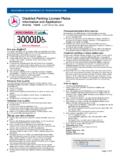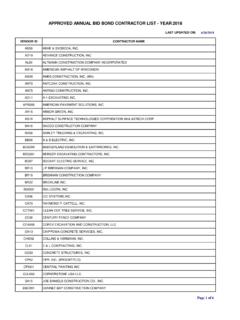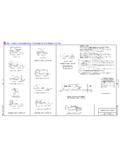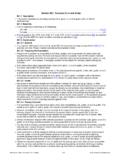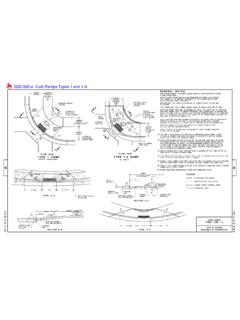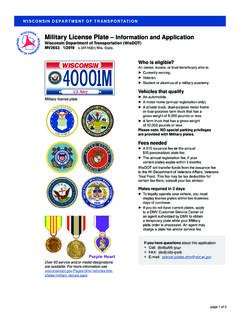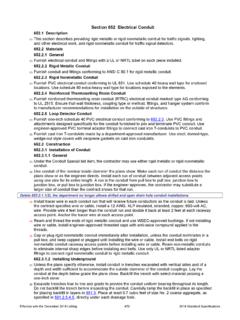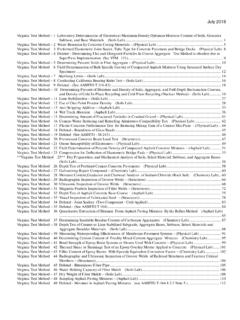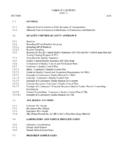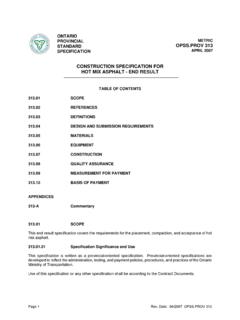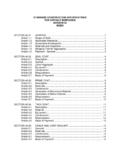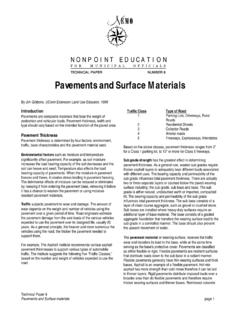Transcription of Construction and Materials Manual Wisconsin Department of ...
1 November 2017 Page 1 Construction and Materials Manual Wisconsin Department of Transportation Chapter 8 Materials Testing, Sampling, Acceptance Section 66 asphalt Mixture Design Materials sampling and testing methods and documentation procedures prescribed in chapter 8 of the CMM are mobilized into the contract per Standard Spec and Standard Spec asphalt material sampling and testing methods as prescribed in CMM are mobilized into the contract per Standard Spec and Standard Spec 460. Asphaltic Mixture Design Provide an Asphaltic Mixture Design Job Mix Formula (JMF) report representing the Materials intended for use along with their proportions for producing the final product. These procedures infer laboratory mixed and compacted specimens unless designated otherwise. Accountability for JMF Mix Design Reports is to be with Highway Technician Certification Program (HTCP) certified personnel and comply with the Materials and mix design requirements of Standard Spec 460.
2 If a contractor uses a consulting laboratory to supply a mix design, the Contractor must authorize in writing that the consultant acts as the contractor s agent during the mix design approval process. During the mix design submittal process, WisDOT will only accept two (2) passing designs per each nominal maximum aggregate size or one (1) mix design per combined bid item (whichever is greater), per project. During Construction , any approved mix design matching the pay item may be used. When a mix design is to be submitted using Atwood s System a current WisDOT project is required. The following default WisDOT project number shall be used 0250-11-11 on the 249 submittal form when a current WisDOT project number is not available at time of design. An example would be a non-DOT project requiring a DOT approved mix design. Any mix design approaching expiration, can be renewed with a one point verification and will retain its original 250 number when renewed on the approved list.
3 Any mix design that had been issued a 250 number not using the 249 form may contact the Bureau of Technical Services (BTS) for instruction on how to obtain a 250 number in the current calendar year. Acronyms and Definitions Interpret Materials related acronyms and definitions in accordance with Standard Spec Laboratory Standard Method of Asphaltic Mix Design (previously called WisDOT Test Method 1559) Description This method is used to determine the optimum asphalt binder content for virgin asphaltic mixtures and asphaltic mixtures containing recycled asphaltic Materials (RAM). This method also defines the submittal requirements pertaining to mix design reports and Materials , as well as any field changes affecting mix design reports. General Required test procedures for aggregate and hot mix asphalt (HMA) are shown below in Table 1 and Table 2. CMM 8-66 asphalt November 2017 Page 2 Table 1 Required Aggregate Test Procedures AGGREGATE TEST TEST PROCEDURE Materials Finer than No.
4 200 ( ) AASHTO T 11 Sieve Analysis of Aggregates AASHTO T 27 Mechanical Analysis of Extracted Aggregate AASHTO T 30 Sieve Analysis of Mineral Filler AASHTO T 37 Liquid Limit of Soils (from source aggregate quality report #225 or #162) AASHTO T 89 Plastic Limit of Soils (from source aggregate quality report #225 or #162) AASHTO T 90 Los Angeles Abrasion of Coarse Aggregate (from #225 report) AASHTO T 96 Specific Gravity and Absorption of Fine Aggregate AASHTO T 84 Specific Gravity and Absorption of Coarse Aggregate AASHTO T 85 Flat and Elongated Particles in Coarse Aggregates ASTM D4791 Soundness of Aggregate (from #225 report) AASHTO T 104 Freeze-Thaw (from #225 report) AASHTO T 103 Fractured Faces (CAA) ASTM D5821 Uncompacted Voids Content of Fine Aggregates (FAA) AASHTO T 304 Sand Equivalency (Plastic Fines) AASHTO T 176 Note: The majority of test result parameters are referenced in Table 460-1 in Standard Spec or Table 460-2 in Standard Spec Table 2 Required HMA Test Procedures HMA TEST TEST PROCEDURE Practice for Superpave Volumetric Design for HMA AASHTO R35 Specification for Superpave Volumetric Mix Design AASHTO M323 Standard Practice for Mixture Conditioning HMA AASHTO R30 Standard Method for Preparing and Determining the Density of HMA AASHTO T 312 Specimens by Means of the SHRP Gyratory Compactor Bulk Specific Gravity of Compacted Bituminous Mixtures AASHTO 166 Using Saturated Surface-Dry Specimens Maximum Specific Gravity of Bituminous Paving Mixtures AASHTO 209 % Air Voids in Compacted Dense and Open Bituminous Paving Mixtures AASHTO 269 Resistance of Compacted Bituminous Mixture to Moisture AASHTO T 283 Determination of Draindown for Uncompacted asphalt Mixtures AASHTO T305 WisDOT Standard
5 Specifications for Asphaltic Concrete Pavement Standard Spec 460 Quantitative Extraction of asphalt Binder from Hot Mix asphalt (HMA)* AASHTO T164 asphalt Content by Ignition Oven* AASHTO T308 Note: * these are not required as part of the mix design process Summary of the Practice 1. Select aggregate components and the asphalt binder to be used, and determine the required properties defining those Materials . 2. Design an aggregate structure (or multiple trial aggregate structures). Determine aggregate component blend percentages. 3. Determine trial asphalt binder contents (estimated by experience or by calculation based on aggregate properties of trial blends). - Compact gyratory specimens using a minimum of 3 times, preferably 4, asphalt binder contents ( increments) and covering a range to include the estimated optimum design binder content. Use Ndes for compaction effort. CMM 8-66 asphalt November 2017 Page 3 - All new mix design need at least one point that is a minimum of below Air Voids ( Va) and one point that is at least above Air Voids ( Va) - Compare trial binder content results.
6 Select an optimum design binder content (by either graphing or interpolating the trial data results) meeting requirements as stated in Standard Spec 460. 4. Evaluate additional properties at the selected optimum design binder content. - Moisture Susceptibility (using AASHTO T 283). - Validate compliance of %Gmm at Nmax and Nini by compacting 2 specimens at the design binder content to Nmax gyrations. - For SMA designs, AASHTO T305 must be followed and testing conducted at two temperatures. The two temperatures should be the anticipated production temperature and +15 C above the anticipated production temperature. Mix must be prepared at optimum AC%. Report the average percent Draindown (average percent of the mixture that drained) at each of the test temperatures. - Draindown value at anticipated production temperature and at 15 C above anticipated production temperature, average of two (2) values at each temperature is required.
7 5. Complete a mix design report identifying Materials used and summarizing volumetric properties in meeting required specifications in CMM 6. Submit the mix design report, and representative Materials when requested or required, to the Department for review per CMM Additional guidance for Materials selection and component composition involved in the mix design process can be referenced in, but not limited to, the following: Superpave Mix Design Manual SP-2 ( asphalt Institute) Mix Design Methods for asphalt Concrete MS-2 ( asphalt Institute) NCHRP 9-33 (A Mix Design Manual for Hot Mix asphalt ) NCHRP Report 673 (A Manual for Design of Hot Mix asphalt with Commentary) Materials and Test Procedures: Additional Guidance Aggregates Refer also to CMM 8-60 and Standard Spec Test the aggregate source material for quality properties (LA wear, soundness, freeze-thaw, etc.) in accordance with the current Department policy and required frequency.
8 Count the current Construction season as one year of aggregate quality eligibility. The mix designer, using the previously listed test methods determines the aggregate properties with the following exceptions or comments: - Fine aggregate angularity (FAA) is determined using Method A (AASHTO T 304) on each individual component with more than 10% passing #8 sieve ( ) and on the current JMF blend. - A specific gravity must be completed on each P-#8 component following AASHTO T84. The extracted aggregate from RAM shall be obtained through the extraction process by either of the following: - Ignition oven - Chemical extraction - Flat and elongated particles are determined using particles retained on the #4 sieve ( ) and larger. The determination of the F&E percentage is based on weight; however, the sample size is intended to be by count (200 pieces, minimum). Asphaltic Binder Material Select an asphalt binder meeting the contract requirements and having been defined or graded according to AASHTO M332.
9 (refer to CMM 8-65) The asphalt binder source and grade indicated on the JMF Mix Design report must represent the material used during the mix design process in determining the optimum asphalt content. If recycled asphaltic Materials are part of the mix design, additionally refer to Standard Spec During production, it is permissible to use a binder designation that is higher than that of the approved design. However, a lower binder designation may require a verification check to be submitted. For example, if a mix was designed for use with PG 58-28S, it is acceptable for use with H and V grades with no additional testing. If a design was approved with PG 58-28H, it is acceptable for use with a V grade with no additional testing. CMM 8-66 asphalt November 2017 Page 4 However, if dropping to an S grade, evaluate the mix design criteria listed below. If all criteria are met, no additional testing is required and S grade is approved for use.
10 If any of the conditions are not met, a verification check is required for the property in question. Property JMF Criteria TSR* > 77% %Gmm at Nini < (for HT mixes) %Gmm at Nmax < * Compacted using AC corresponding to air voids @ Ndes at (+/- ) air voids, using current JMF blend, with all current approved JMF changes. - If the resultant verification check (one-point) indicates a need to adjust the mix design targets or component combinations to meet specifications, then additional testing and separate design submittal is required. If the PG binder grade changes from original design (-28 to a -34 or vice versa), a separate mix design submittal is required. Change in the asphalt binder source during production is acceptable if the new supplier is on the current WisDOT's approved products list (APL), and sampled/tested accordingly, and the engineer is notified in writing of any change.
